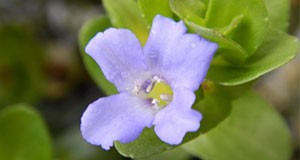 Lemon bacopa is a native aquatic and wetland plant that is a welcome inclusion in a variety of settings, including water gardens, aquatic ponds, and wetland restoration and mitigation sites. The species is broadly adapted and extremely common throughout Florida, and its perennial nature assures a stellar performance year after year. Although lemon bacopa can be weedy in some situations, it is most often considered a beneficial native plant that brings a number of desirable characteristics to almost any aquatic setting. This 3-page fact sheet was written by Lyn Gettys and Carl J. Della Torre III, and published by the UF Department of Agronomy, April 2015. (Photo: Lyn Gettys, UF/IFAS)
Lemon bacopa is a native aquatic and wetland plant that is a welcome inclusion in a variety of settings, including water gardens, aquatic ponds, and wetland restoration and mitigation sites. The species is broadly adapted and extremely common throughout Florida, and its perennial nature assures a stellar performance year after year. Although lemon bacopa can be weedy in some situations, it is most often considered a beneficial native plant that brings a number of desirable characteristics to almost any aquatic setting. This 3-page fact sheet was written by Lyn Gettys and Carl J. Della Torre III, and published by the UF Department of Agronomy, April 2015. (Photo: Lyn Gettys, UF/IFAS)
http://edis.ifas.ufl.edu/ag392
Category: Environment
Anagyrus pseudococci Girault (Insecta: Hymenoptera: Encyrtidae)
 Anagyrus pseudococci is an economically important biological control agent commonly used against the vine mealybug (which infests wine grapes) and the citrus mealybug. It is a solitary, internal parasitoid and lays one egg per host, with the larva developing inside the host’s body. The wasps may be commercially reared and distributed inside mummies, and they will emerge within 1-5 days after delivery. Application involves placing a bottle containing the mummies in a dry spot of the crop and allowing the adults to emerge. This 5-page fact sheet was written by Theresa Chormanski and Ronald D. Cave, and published by the UF Department of Entomology and Nematology, March 2015. (Photo: Kent M. Dane)
Anagyrus pseudococci is an economically important biological control agent commonly used against the vine mealybug (which infests wine grapes) and the citrus mealybug. It is a solitary, internal parasitoid and lays one egg per host, with the larva developing inside the host’s body. The wasps may be commercially reared and distributed inside mummies, and they will emerge within 1-5 days after delivery. Application involves placing a bottle containing the mummies in a dry spot of the crop and allowing the adults to emerge. This 5-page fact sheet was written by Theresa Chormanski and Ronald D. Cave, and published by the UF Department of Entomology and Nematology, March 2015. (Photo: Kent M. Dane)
http://edis.ifas.ufl.edu/in1081
Zombie Fly (suggested common name) Apocephalus borealis Brues (Insecta: Diptera: Phoridae)
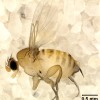 The zombie fly is primarily a parasitoid of bumble bees and wasps in North America. In 2012, Dr. John Hafernik and his colleagus at San Francisco State University discovered that Apocephalus borealis also parasitizes honey bees. Parasitized honey bees show zombie-like behavior by leaving their hives at night and are often attracted to nearby lights where they show disoriented behavior and die in a few hours. This 5-page fact sheet was written by Nicole A. Casuso, Ashley N. Mortensen, and James D. Ellis, and published by the UF Department of Entomology and Nematology, October 2014. (Photo: Jessica Andrieux, CC SA-BY 2.5)
The zombie fly is primarily a parasitoid of bumble bees and wasps in North America. In 2012, Dr. John Hafernik and his colleagus at San Francisco State University discovered that Apocephalus borealis also parasitizes honey bees. Parasitized honey bees show zombie-like behavior by leaving their hives at night and are often attracted to nearby lights where they show disoriented behavior and die in a few hours. This 5-page fact sheet was written by Nicole A. Casuso, Ashley N. Mortensen, and James D. Ellis, and published by the UF Department of Entomology and Nematology, October 2014. (Photo: Jessica Andrieux, CC SA-BY 2.5)
http://edis.ifas.ufl.edu/in1063
Contaminants in the Urban Environment: Perfluoroalkyl Substances
 Perfluoroalkyl substances (PFASs) or perfluorochemicals (PFCs) are the most widespread and persistent manmade chemicals on earth. Common products that contain PFASs are Teflon pans, non-stick cookware, rain/waterproof jackets (like Gore-Tex), fire-fighting foams, food packaging, carpets, and furniture fabrics. PFASs stay in the environment for a long period of time, which means they can accumulate in organisms to levels that cause harmful effects. This 9-page fact sheet discusses the occurrence, use, exposure, and potential harmful effects of PFASs to humans and the environment, and suggests ways to reduce your exposure to PFSAs. Written by Ignacio A. Rodriguez-Jorquera and Gurpal S. Toor, and published by the UF Department of Soil and Water Science, March 2015. (Photos: Thinkstock.com)
Perfluoroalkyl substances (PFASs) or perfluorochemicals (PFCs) are the most widespread and persistent manmade chemicals on earth. Common products that contain PFASs are Teflon pans, non-stick cookware, rain/waterproof jackets (like Gore-Tex), fire-fighting foams, food packaging, carpets, and furniture fabrics. PFASs stay in the environment for a long period of time, which means they can accumulate in organisms to levels that cause harmful effects. This 9-page fact sheet discusses the occurrence, use, exposure, and potential harmful effects of PFASs to humans and the environment, and suggests ways to reduce your exposure to PFSAs. Written by Ignacio A. Rodriguez-Jorquera and Gurpal S. Toor, and published by the UF Department of Soil and Water Science, March 2015. (Photos: Thinkstock.com)
http://edis.ifas.ufl.edu/ss631
Contaminants in the Urban Environment: Pharmaceuticals and Personal Care Products (PPCPs), Parts 1 and 2
 Pharmaceuticals and personal care products contain a variety of chemical substances that enter household wastewater from bath and shower, sinks, and washers and ultimately find their way into the environment. Continuous discharge of wastewater contributes to the accumulation of these substances in the environment — where they can be harmful to organisms. These fact sheets were written by Yun-Ya Yang and Gurpal S. Toor, and published by the UF Department of Soil and Water Science, March 2015. (Photo: iStock/Thinkstock.com)
Pharmaceuticals and personal care products contain a variety of chemical substances that enter household wastewater from bath and shower, sinks, and washers and ultimately find their way into the environment. Continuous discharge of wastewater contributes to the accumulation of these substances in the environment — where they can be harmful to organisms. These fact sheets were written by Yun-Ya Yang and Gurpal S. Toor, and published by the UF Department of Soil and Water Science, March 2015. (Photo: iStock/Thinkstock.com)
Part 1 provides an overview of the use and sale of PPCPs in the United States and the world: http://edis.ifas.ufl.edu/ss632
Part 2 discusses the sources and impacts of PPCPs and offers common-sense ways we can protect our environment from PPCPs.
http://edis.ifas.ufl.edu/ss633
Economic Contributions and Ecosystem Services of Springs in the Lower Suwannee and Santa Fe River Basins of North-Central Florida
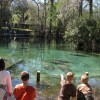 This study examined the economic contributions, consumer surplus, and ecosystem services provided by recreational use of fifteen major springs sites in north central Florida. The estimated annual economic contributions of springs-related recreational spending in north-central Florida for FY 2012/13 are summarized. Among the findings, there was $84.2 million in total visitor spending for springs recreation, and 1,160 full- and part-time jobs. This 4-page fact sheet was written by Tatiana Borisova, Alan W. Hodges, and Thomas J. Stevens, and published by the UF Department of Food and Resource Economics, April 2015.
This study examined the economic contributions, consumer surplus, and ecosystem services provided by recreational use of fifteen major springs sites in north central Florida. The estimated annual economic contributions of springs-related recreational spending in north-central Florida for FY 2012/13 are summarized. Among the findings, there was $84.2 million in total visitor spending for springs recreation, and 1,160 full- and part-time jobs. This 4-page fact sheet was written by Tatiana Borisova, Alan W. Hodges, and Thomas J. Stevens, and published by the UF Department of Food and Resource Economics, April 2015.
http://edis.ifas.ufl.edu/fe958
Managing Conflicts with Wildlife: Living with Snakes
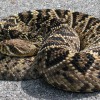 Snakes provide numerous benefits to people and to the environment, by controlling rat and mice populations in the environment, for example. Or in the laboratory, where pygmy rattlesnake venom research helped develop medicine to thin the blood of heart attack patients. Most snakes are secretive and rarely bother people, but there are situations where some snakes can become dangerous. In this 4-page fact sheet, we present some facts about snakes, describe dangers they may cause, and provide suggestions on how to cope with these dangers. Written by Holly K. Ober, Steve Johnson, and William M. Giuliano, and published by the UF Department of Wildlife Ecology and Conservation, November 2014. (Photo: Steve Johnson)
Snakes provide numerous benefits to people and to the environment, by controlling rat and mice populations in the environment, for example. Or in the laboratory, where pygmy rattlesnake venom research helped develop medicine to thin the blood of heart attack patients. Most snakes are secretive and rarely bother people, but there are situations where some snakes can become dangerous. In this 4-page fact sheet, we present some facts about snakes, describe dangers they may cause, and provide suggestions on how to cope with these dangers. Written by Holly K. Ober, Steve Johnson, and William M. Giuliano, and published by the UF Department of Wildlife Ecology and Conservation, November 2014. (Photo: Steve Johnson)
http://edis.ifas.ufl.edu/uw395
Tawny Crazy Ant (previously known as Caribbean crazy ant) Nylanderia (formerly Paratrechina) fulva (Mayr) (Insecta: Hymenoptera: Formicidae: Formicinae)
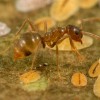 Nylanderia fulva is part of a group of ants referred to as “crazy ants” due to their quick and erratic movements. It has been reported from 27 counties of Florida and 27 counties of Texas, as well as from Louisiana, Mississippi, Alabama and Georgia. Huge number of workers in infested areas can make human activities uncomfortable and difficult. They can infest sidewalks, buildings and gardens, and damage phone lines, air conditioning units and computers. They have killed honey bee larvae and used the hives as their nests, and are even displacing red imported fire ants where the two populations overlap in Texas. This 5-page fact sheet was written by Shweta Sharma, John Warner, and Rudolph H. Scheffrahn, and published by the UF Department of Entomology and Nematology, December 2014. (Photo: Lyle Buss, UF/IFAS)
Nylanderia fulva is part of a group of ants referred to as “crazy ants” due to their quick and erratic movements. It has been reported from 27 counties of Florida and 27 counties of Texas, as well as from Louisiana, Mississippi, Alabama and Georgia. Huge number of workers in infested areas can make human activities uncomfortable and difficult. They can infest sidewalks, buildings and gardens, and damage phone lines, air conditioning units and computers. They have killed honey bee larvae and used the hives as their nests, and are even displacing red imported fire ants where the two populations overlap in Texas. This 5-page fact sheet was written by Shweta Sharma, John Warner, and Rudolph H. Scheffrahn, and published by the UF Department of Entomology and Nematology, December 2014. (Photo: Lyle Buss, UF/IFAS)
http://edis.ifas.ufl.edu/in1071
Fiddlewood leafroller, seagrape moth (suggested common names) Epicorsia oedipodalis (Guenée, 1854) (Lepidoptera: Ditrysia: Pyraloidea: Pyralidae: Pyraustinae)
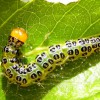 These caterpillars roll up leaves of the host plants and use the rolled leaves as larval retreats and locations for pupal cocoons. Although these leaf-eating pests do no permanent damage, they can completely defoliate fiddlewood, a Florida native that can form a large shrub or small tree. The shrub simply puts out a new flush of leaves. The larvae themselves are valuable food source for baby birds during the spring dry season in Florida. This 4-page fact sheet was written by William H. Kern, and published by the UF Department of Entomology and Nematology, February 2015. (Photo:W.H. Kern, Jr., UF/IFAS/FLREC)
These caterpillars roll up leaves of the host plants and use the rolled leaves as larval retreats and locations for pupal cocoons. Although these leaf-eating pests do no permanent damage, they can completely defoliate fiddlewood, a Florida native that can form a large shrub or small tree. The shrub simply puts out a new flush of leaves. The larvae themselves are valuable food source for baby birds during the spring dry season in Florida. This 4-page fact sheet was written by William H. Kern, and published by the UF Department of Entomology and Nematology, February 2015. (Photo:W.H. Kern, Jr., UF/IFAS/FLREC)
http://edis.ifas.ufl.edu/in1079
Squash Vine Borer Melittia cucurbitae (Harris) (Insecta: Lepidoptera: Sesiidae)
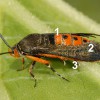 Squash vine borer is a moth species that is active during the day (diurnal). The larvae complete their growth and development on wild and domesticated species of the genus Cucurbita. Once only considered a nuisance to commercial growers, with the expansion of cucurbit production in the United States over the last decade, the squash vine borer has become a pest of economic importance. This 5-page fact sheet was written by Eutychus Kariuki and Jennifer L. Gillett-Kaufman, and published by the UF Department of Entomology and Nematology, December 2014. (Photo: Lyle J. Buss, UF/IFAS)
Squash vine borer is a moth species that is active during the day (diurnal). The larvae complete their growth and development on wild and domesticated species of the genus Cucurbita. Once only considered a nuisance to commercial growers, with the expansion of cucurbit production in the United States over the last decade, the squash vine borer has become a pest of economic importance. This 5-page fact sheet was written by Eutychus Kariuki and Jennifer L. Gillett-Kaufman, and published by the UF Department of Entomology and Nematology, December 2014. (Photo: Lyle J. Buss, UF/IFAS)
http://edis.ifas.ufl.edu/in1068
Rice Bug (suggested common name) Leptocorisa acuta (Thunberg) (Insecta: Hemiptera: Alydidae)
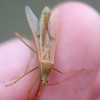 Broad-headed bugs belong to a well-known but relatively small family of plant-feeding true bugs, usually seen feeding on the foliage and flowers of leguminous and graminaceous crops. Leptocorisa acuta (Thunberg) can be found on many crop plants in the family Poaceae (grasses), especially rice, and is a reported pest of economic significance in rice-producing countries like India, Australia, and China. This 3-page fact sheet was written by Amelio Chi Serrano, Russell F. Mizell, III, and Morgan A. Byron, and published by the UF Department of Entomology and Nematology, December 2014. (Photo: Lary E. Reeves, UF/IFAS)
Broad-headed bugs belong to a well-known but relatively small family of plant-feeding true bugs, usually seen feeding on the foliage and flowers of leguminous and graminaceous crops. Leptocorisa acuta (Thunberg) can be found on many crop plants in the family Poaceae (grasses), especially rice, and is a reported pest of economic significance in rice-producing countries like India, Australia, and China. This 3-page fact sheet was written by Amelio Chi Serrano, Russell F. Mizell, III, and Morgan A. Byron, and published by the UF Department of Entomology and Nematology, December 2014. (Photo: Lary E. Reeves, UF/IFAS)
http://edis.ifas.ufl.edu/in1067
BOOKSTORE: SP 496 Trees: North & Central Florida ($24.95)
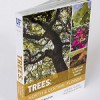 This sturdy, pocket-sized field guide–the only one of its kind for north and central Florida–is designed for landscape professionals, arborists, naturalists, gardeners, and anyone seeking to know the trees around them. Full color photographs of leaves, bark, flowers and full trees, together with clear descriptions and other information make identifying trees easier than ever. The book also features a handy diagnostic key, an introduction to plant parts, a glossary and a ruler to guide you, whether you’re a trained botanist or a total beginner. This field guide to 140 common tree species is written by Andrew Koeser, Gitta Hasing, Melissa Friedman, and Robert Irving and published by UF/IFAS. Available only at the UF/IFAS Extension Bookstore.
This sturdy, pocket-sized field guide–the only one of its kind for north and central Florida–is designed for landscape professionals, arborists, naturalists, gardeners, and anyone seeking to know the trees around them. Full color photographs of leaves, bark, flowers and full trees, together with clear descriptions and other information make identifying trees easier than ever. The book also features a handy diagnostic key, an introduction to plant parts, a glossary and a ruler to guide you, whether you’re a trained botanist or a total beginner. This field guide to 140 common tree species is written by Andrew Koeser, Gitta Hasing, Melissa Friedman, and Robert Irving and published by UF/IFAS. Available only at the UF/IFAS Extension Bookstore.
Wellsina Mite Hemicheyletia wellsina (De Leon) (Arachnida: Acari: Cheyletidae)
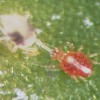 This predatory mite was recently discovered in an unsprayed greenhouse at the University of Florida, Gainesville, living on Phalaenopsis and Dendrobium orchids, and assumed to be feeding on orchid pests such as spider mites, tenuipalpid mites, and mealybugs that were present on the orchids. Because there was no published information on this species as a natural enemy of orchid pests, colonies were initiated here to study its biology, maintained on two-spotted spider mite prey. Hemicheyletia wellsina does not appear likely to be an effective natural enemy in agricultural crops as an introduced predator, but could be beneficial in natural biological control in natural ecosystems, where pest densities are lower. This 5-page fact sheet was written by Haleigh A. Ray and Marjorie A. Hoy, and published by the UF Department of Entomology and Nematology, December 2014. (Photo: Haleigh Ray, UF/IFAS)
This predatory mite was recently discovered in an unsprayed greenhouse at the University of Florida, Gainesville, living on Phalaenopsis and Dendrobium orchids, and assumed to be feeding on orchid pests such as spider mites, tenuipalpid mites, and mealybugs that were present on the orchids. Because there was no published information on this species as a natural enemy of orchid pests, colonies were initiated here to study its biology, maintained on two-spotted spider mite prey. Hemicheyletia wellsina does not appear likely to be an effective natural enemy in agricultural crops as an introduced predator, but could be beneficial in natural biological control in natural ecosystems, where pest densities are lower. This 5-page fact sheet was written by Haleigh A. Ray and Marjorie A. Hoy, and published by the UF Department of Entomology and Nematology, December 2014. (Photo: Haleigh Ray, UF/IFAS)
http://edis.ifas.ufl.edu/in1066
Io Moth Automeris io (Fabricius) (Insecta: Lepidoptera: Saturniidae)
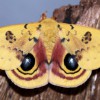 The beautiful Io moth is one of our most recognizable moths, because of its prominent hind wing eyespots. The attractive Io moth caterpillar is also well-known because of its painful sting. But like many of the other saturniid moths, is less common now in parts of its range. With the exception of Cape Cod and some of the Massachusetts islands, it is now rare in New England where it was once common, and its populations have declined in most of the Gulf States since the 1970s. This 12-page fact sheet was written by Donald W. Hall, and published by the UF Department of Entomology and Nematology, December 2014. (Photo: Donald W. Hall, UF/IFAS)
The beautiful Io moth is one of our most recognizable moths, because of its prominent hind wing eyespots. The attractive Io moth caterpillar is also well-known because of its painful sting. But like many of the other saturniid moths, is less common now in parts of its range. With the exception of Cape Cod and some of the Massachusetts islands, it is now rare in New England where it was once common, and its populations have declined in most of the Gulf States since the 1970s. This 12-page fact sheet was written by Donald W. Hall, and published by the UF Department of Entomology and Nematology, December 2014. (Photo: Donald W. Hall, UF/IFAS)
http://edis.ifas.ufl.edu/in1065
The Florida Panther: Past, Present, and Future
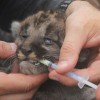 Florida panther was presumed extinct by the early 1950s, but were rediscovered in 1973 by a survey team organized by the National Geographic Society. They were one of the first species to be added to the US endangered species list and are now the only population of North American puma that occurs east of Mississippi River. This 3-page fact sheet describes Florida panther research and management actions, the effects they have had on the population, and continuing challenges. Written by Madelon van de Kerk, David P. Onorato, and Madan K. Oli, and published by the UF Department of Wildlife Ecology and Conservation, February 2015.
Florida panther was presumed extinct by the early 1950s, but were rediscovered in 1973 by a survey team organized by the National Geographic Society. They were one of the first species to be added to the US endangered species list and are now the only population of North American puma that occurs east of Mississippi River. This 3-page fact sheet describes Florida panther research and management actions, the effects they have had on the population, and continuing challenges. Written by Madelon van de Kerk, David P. Onorato, and Madan K. Oli, and published by the UF Department of Wildlife Ecology and Conservation, February 2015.
http://edis.ifas.ufl.edu/uw402
Habitat Requirements of the Florida Panther
 The Florida panther (Puma concolor coryi) was listed as endangered under the Endangered Species Act in 1967. Habitat loss and fragmentation are primary threats, driven by urban development and the conversion of rangelands to row crops, citrus production, and mining. This 3-page fact sheet focuses on which habitats are most important for conservation of the Florida panther. Written by Elizabeth F. Pienaar and Elena C. Rubino, and published by the UF Department of Wildlife Ecology and Conservation, October 2014. (Photo courtesy of the Florida Fish and Wildlife Conservation Commission.)
The Florida panther (Puma concolor coryi) was listed as endangered under the Endangered Species Act in 1967. Habitat loss and fragmentation are primary threats, driven by urban development and the conversion of rangelands to row crops, citrus production, and mining. This 3-page fact sheet focuses on which habitats are most important for conservation of the Florida panther. Written by Elizabeth F. Pienaar and Elena C. Rubino, and published by the UF Department of Wildlife Ecology and Conservation, October 2014. (Photo courtesy of the Florida Fish and Wildlife Conservation Commission.)
http://edis.ifas.ufl.edu/uw390
Nutrient Management of Vegetable and Agronomic Row Crops Handbook
 Through the implementation of a series of targeted cultural practices discussed in this production guide, growers should be able to reconcile economic profitability and responsible use of water and fertilizer. Topics include: proper sampling practices and test interpretations; irrigation management methods and automation; use of alternate fertilizer materials to retain nutrients in the soil but allow adequate supply for crop uptake. Use of these BMPs ensures that adequate fertilizer rates may be achieved by combinations of UF/IFAS recommended base rates and supplemental fertilizer applications. This 199-page handbook was edited by Kelly T. Morgan, and published by the UF Department of Soil and Water Science, February 2015.
Through the implementation of a series of targeted cultural practices discussed in this production guide, growers should be able to reconcile economic profitability and responsible use of water and fertilizer. Topics include: proper sampling practices and test interpretations; irrigation management methods and automation; use of alternate fertilizer materials to retain nutrients in the soil but allow adequate supply for crop uptake. Use of these BMPs ensures that adequate fertilizer rates may be achieved by combinations of UF/IFAS recommended base rates and supplemental fertilizer applications. This 199-page handbook was edited by Kelly T. Morgan, and published by the UF Department of Soil and Water Science, February 2015.
http://edis.ifas.ufl.edu/ss639
Robbing Behavior in Honey Bees
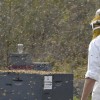 Western honey bee workers can invade and steal honey/nectar from other colonies or sugar/corn syrup from feeders used to deliver syrup to other colonies. This is called “robbing” behavior. Robbing behavior typically involves the collection of nectar and honey, but not pollen or brood. Some beekeepers report that robbing bees may steal wax or propolis from other hives, but there is not much data available on this occurrence. Robbing behavior can escalate quickly from just a few bees robbing other colonies to a massive frenzy of bees robbing many colonies in an apiary. This 3-page fact sheet was written by Ryan Willingham, Jeanette Klopchin, and James Ellis, and published by the UF Department of Entomology and Nematology, February 2015. (Photo Credit: UF/HBREL)
Western honey bee workers can invade and steal honey/nectar from other colonies or sugar/corn syrup from feeders used to deliver syrup to other colonies. This is called “robbing” behavior. Robbing behavior typically involves the collection of nectar and honey, but not pollen or brood. Some beekeepers report that robbing bees may steal wax or propolis from other hives, but there is not much data available on this occurrence. Robbing behavior can escalate quickly from just a few bees robbing other colonies to a massive frenzy of bees robbing many colonies in an apiary. This 3-page fact sheet was written by Ryan Willingham, Jeanette Klopchin, and James Ellis, and published by the UF Department of Entomology and Nematology, February 2015. (Photo Credit: UF/HBREL)
http://edis.ifas.ufl.edu/in1064
Economic Impacts of Highway Beautification in Florida
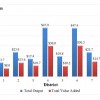 The Florida Department of Transportation is allocated money every year for highway landscaping projects. They make driving more pleasant and are better for the environment, but do they attract private investment and contribute to the economy? This study, commissioned by the FDOT, finds that the average annual economic impacts of highway beautification expenditures in Florida during 2008–2013 amounted to $46 million in output impacts and $28 million in value-added impacts. This 7-page fact sheet was written by Hayk Khachatryan, Alan W. Hodges, Mohammad Rahmani, and Thomas J. Stevens, and published by the UF Department of Food and Resource Economics, December 2014.
The Florida Department of Transportation is allocated money every year for highway landscaping projects. They make driving more pleasant and are better for the environment, but do they attract private investment and contribute to the economy? This study, commissioned by the FDOT, finds that the average annual economic impacts of highway beautification expenditures in Florida during 2008–2013 amounted to $46 million in output impacts and $28 million in value-added impacts. This 7-page fact sheet was written by Hayk Khachatryan, Alan W. Hodges, Mohammad Rahmani, and Thomas J. Stevens, and published by the UF Department of Food and Resource Economics, December 2014.
http://edis.ifas.ufl.edu/fe963
Conservation Subdivision: Post-construction Phase: Policy Directions and the Importance of Assessing Stakeholder Opinions
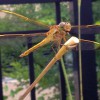 Simply designating open space in a development is not enough to provide long-term protection for a variety of wildlife. New policies need to be developed that encourage developers of conservation developments to adopt long-term management practices that support biodiversity conservation. This 5-page fact sheet discusses policy options that could be used to support conservation management practices and reports on a survey of Colorado landowners who have created conservation developments and their opinions about a policy option to support the implementation of management practices. Written by Daniel Feinberg and Mark Hostetler, and published by the UF Department of Wildlife Ecology and Conservation, December 2014. (Photo credit: Daniel Feinberg)
Simply designating open space in a development is not enough to provide long-term protection for a variety of wildlife. New policies need to be developed that encourage developers of conservation developments to adopt long-term management practices that support biodiversity conservation. This 5-page fact sheet discusses policy options that could be used to support conservation management practices and reports on a survey of Colorado landowners who have created conservation developments and their opinions about a policy option to support the implementation of management practices. Written by Daniel Feinberg and Mark Hostetler, and published by the UF Department of Wildlife Ecology and Conservation, December 2014. (Photo credit: Daniel Feinberg)
http://edis.ifas.ufl.edu/uw401